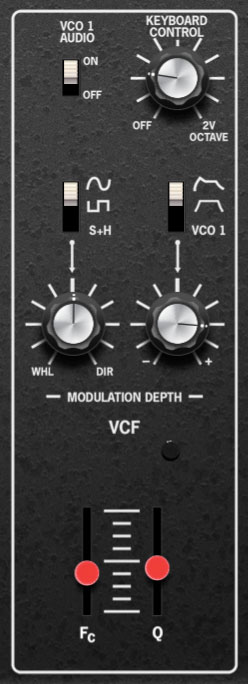
Cherry Audio's Cat filter is based upon the original four-pole 24 db/oct "cascaded OTA" SSM2040 filter. This filter was used in a number of 70s and 80s analog synths, including the original Rev 1 and Rev 2 Prophet-5.
VCO 1 Audio- Enables or disables input from VCO 1. The intention of this control is to disable VCO 1's sound when it's used strictly as a mod source and you don't want to hear it.
Keyboard Control- This causes the cutoff frequency to increase as ascending notes are played on a keyboard. The idea behind this is, because actual note frequencies rise as higher pitches are played, the Keyboard Control switches adds a rising CV to the cutoff frequency in order to maintain the brightness of notes as higher pitches are played.
When set to its middle position, the cutoff frequency tracks the keyboard at 1V/oct, just like the oscillators. This allows the filter to be used as a "third oscillator," outputting a pure sine wave - it's particularly effective when combined with the noise (Noise Level) source.
Modulation Depth controls- The two Modulation Depth knobs and slide switches determine the routing and amount of VCF cutoff frequency modulation.
Mod routing 1- The slider switch selects between sine wave, square wave, or sample and hold LFO modulation. The knob sets the amount of cutoff frequency modulation; at center setting, modulation is off. Turning the knob to the right applies constant (Dir) modulation. Turning the knob to the left (Whl) applies mod via a USB/MIDI controller mod wheel with the knob setting the maximum amount of mod. LFO frequency, delay, and host sync are set in the LFO section to the left.
Mod routing 2- The slider switch selects the mod source - ADSR envelope generator, AR envelope generator, or VCO 1. Turning the knob clockwise from center adds positive modulation; turning the knob counterclockwise applies negative modulation.
Fc (Cutoff Frequency)- The filter removes high harmonics as the slider setting is decreased from max, resulting in a dulling of sound.
Q (Resonance)- Emphasizes sound energy at and around the current cutoff frequency by adding feedback from the filter's output back to its input. At lower settings, this can be used to create mild resonances such as those heard in acoustic instruments.
The Cat's resonance circuit is unique and can result in some SERIOUS squelching and screaming at higher settings, so be very cautious with volume when cranking the Q slider.